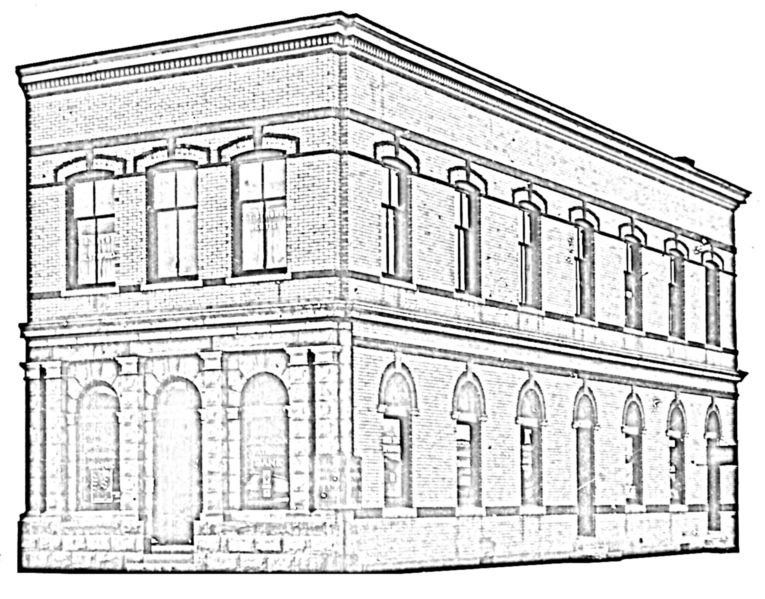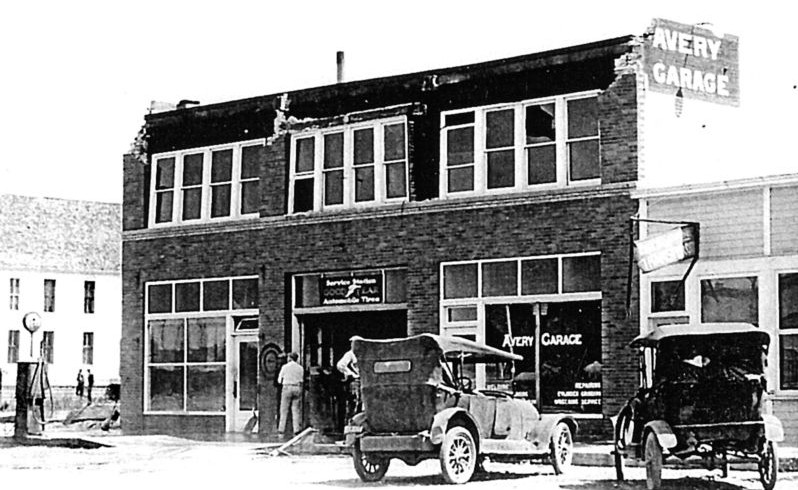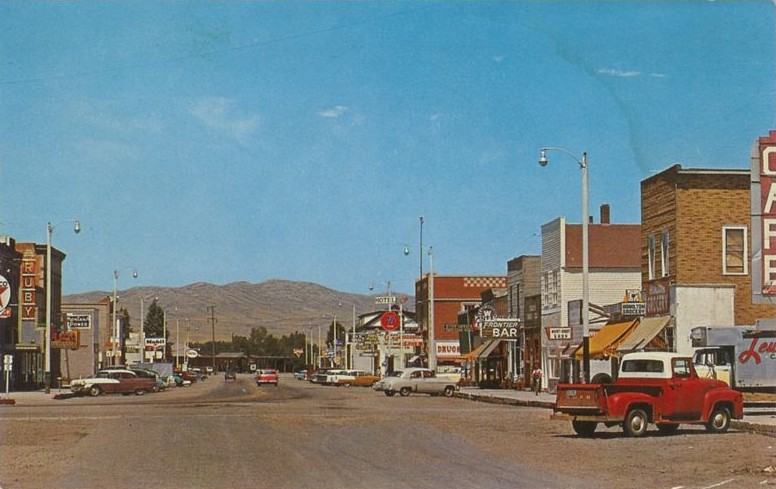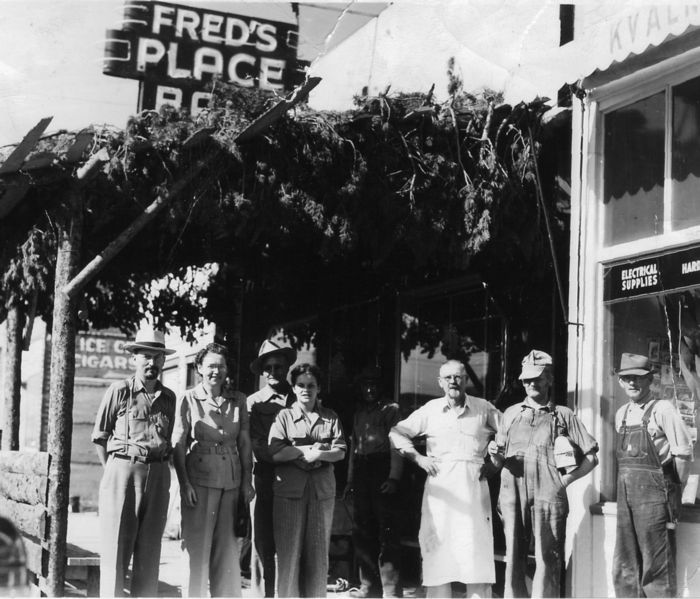Excerpt from Headwaters Heritage History, 1983, Three Forks Area Historical Society
Willow Creek is located in the east one-half of Section 19, Township 1 N, Range 1 E; the initial corner stone for surveying the
state being on the hill about two miles south of town. The creek was named "Pholosipher's River" by Clark and later renamed Willow
Creek by the early settlers because of the thickets of willows that grew along the banks.
Captain William Clark noted the following in his journal on July 25, Thursday, 1805:
I wrote a note informing Cap' Lewis the
rout I intended to take, and proceeded on up the main North fork thro' a Vallie, the day verry hot, about 6 or 8 miles up the North
fork a small rapid river falls in on the Lar Side which affords a great Deel of water and appears to head in the Snow mountains to
the SW. This little river falls into the Missouri by three mouthes, haveing seperated after it arrives in the river bottoms, and
contains as also all the water courses in this quarter emence number of beaver & orter maney thousand enhabit the river & creeks
near the 3 forks (Pholosipher's River).
The stage route from Virginia City to Helena and Bozeman passed through the Upper Willow Creek valley. There was a stage station at
Marvin Haskins' Ranch (Buttelman) and also the O'Neil Place (Guy Warren). T. J. Murphy operated a stage line and had a farm in the
Galen Springs area. Other early settlers were William Flowers, the Neal Brothers, C. M. Tate, James Turner, George Thompson, Warren,
Bill and Jim Logan, Packnell, Andrew and Curry Moore, Terry Burns, George Miller, Robert Parker, the Milligan Brothers, James Uhler,
Norman and Andrew Head, Col. Woods, McGaugh, Mr. Leeper, Dr. Keeler, Tilson, Boyce and Martin.
The pioneers used tents or covered wagon boxes for shelter until cabins could be built. The cabins had a fireplace and they made what
furniture was needed. Breaking the sod for farming was difficult and often only a few acres a year could be added. A man walked and
guided an oxen-drawn plow and then a crude harrow was used to break up the soil so planting could be done. Harvesting was done with a
hand scythe for both hay and grain. A cradle was attached to the scythe which caught and held the grain so it could be bundled and
tied by hand and then a flail was used to pound out the grain. They were an innovative people and used every means to make work
easier. Some of these early settlers brought cattle and horses with them and these animals were the beginning of the fine herds in
this area.
The winter of 1864 was very hard and food, such as flour, was scarce and costly. Most lived on wild game. The first church service
by Rev. L. B. Stateler was held in the Nave cabin on Christmas Day 1864. Each brought some food and a Christmas dinner was had.
Mount Green Cemetery had its beginning on December 31, 1864, in a howling blizzard. A lone man, struggling through the storm toward
Willow Creek, made it to the hill, where the cemetery is now located, when he fell exhausted and froze to death about halfway between
the James Green and McGaugh cabins. The next morning members of the McGaugh family found him and he was buried unidentified at this
point where he was found. James Green later donated sufficient land for a community cemetery there.
The Sturgis Ranch was a stage station and also served as a post office and some provisions could be gotten there. Jaynes Store at
the site of the present Jack Cooper Ranch was a general store. After Jaynes it was run by James Smart; then Ben Wells in partnership
with Gurdon Campbell. Pink Robbins took over from Wells, followed by Cook and Wilkins and later John Cherry. Thomas Williams ran the
store after Cherry.
The Northern Pacific Railroad came through Willow Creek in 1887. At that time the town moved nearer the tracks for convenience.
A Mr. Flynn operated a store there and A. J. Woodward built a store at the new site. "Uncle Tom" Williams' store became isolated so
he moved it to a spot between the other two.
In 1891, a news report stated there were two stores, a saloon and a blacksmith shop. "William Reed is the best blacksmith in the
seven counties, Lee Crooks furnishes the liquor for the boys, A. J. Woodward runs one store and James Smart the other." Also
James Green put up a little store by the railroad.
The Milwaukee followed in 1908. The coming of the railroads was a giant step toward opening up the country. Supplies became more
readily available and cheaper. Stock was shipped by train to Chicago to be sold. Speculation was high that a roundhouse would be
built in Willow Creek, but it was constructed in Three Forks instead.
In 1901, there was a dredge in the Jefferson River. This venture was not a success for it cost between eight and ten thousand dollars
and still they were not able to save the fine gold and black sand. Lots were laid out and sold in 1910. The homesteaders came and
settled, many on the South Bench. The wheat yields averaged from 30 to 44 bushels an acre. Two claimed to have oats that ran 77 and
88 bushels an acre. The hard times came in 1919 with low prices and drought and many moved to other areas. Some that came were Mason,
Summers, Frank Stevens, Garret Bros., Ruegamer, Hudson Sheep Ranch, Harry Salkie, Jim Waldon, Luick, Charley Friedeman, Cunningham,
Babb, John Van Horn, George Sharp, Bettum Angles, Bunce, Barviere, De Fosie, Gerard, Cahill, Beliele, Larson, McGrady, Andy Groan,
Wild Bill Vanewyk, John Sheppard, Lee Purcell, John Divine, Mone Howells, Fred Orem, Jenny Healy, Erdman, James Seahorn, W. W.
Sleight, Hemple and Selway, Briggs and McPherson, Dickman.
Soon there were other businesses as the A. J. Woodward Hotel, the Hare Store (1902-1910), Rask & Joseph Store and Lumber Yard,
and Al Dance's Saloon. A grain elevator was built on the Northern Pacific and is still there and another, Grain Growers Co-op, was
built in 1912 on the Milwaukee, but was completely destroyed by fire in 1921. Ed Walbert had a Feed and Livery Barn, Clint Hale a
garage, and there was the King Shoe Shop. In 1914 Thorndike and Nelson opened a bank in Willow Creek, but it failed and was closed
in 1923. Sarkis Joseph sold his lumber yard to Nelson in 1914. A cheese factory opened in 1915 and operated a few years, but was
dismantled in 1921 and shipped to Twin Bridges. Jet Shanholtzer purchased the West Blacksmith Shop in 1916. Dr. Bradbury came in
1914 and was the doctor in Willow Creek for many years. Bertie Heltzel had a millinery shop between the Drug Store and Sarkis Joseph's
store. After Joseph's death Earl Parks moved across the street to the Joseph building. Mrs. Mulderig operated a boarding house in
the alley just back of "Uncle Tom" Williams' store. Across the street from the Drug Store was the Swope Restaurant. There was an ice
house in the alley behind the Pool Hall. There was a tennis court, which was used for several years, before the Power Hardware building
took the site. Henry Babb bought a Pilot automobile and opened a sales office and shop just south of the Mack and Black garage;
however, the car was made for only a short time so his business did not prosper. The Babcock-Bell building had a dance hall upstairs
and the lower floor a saloon and barber shop. There was a theatre, Ted Cooper's meat market, and at one time five barbers in Willow
Creek.
Electric lights came in 1918. The Mack and Black garage had a generator run by a diesel engine which provided power for houses and
street lights. It was a direct current system with storage batteries. The diesel ran from 4 til 10 p.m. but by 2 p.m. the batteries were
so low that a light bulb would only glow red. It was sold to Electric Power Company in 1920. The garage also had a gasoline pump, first
a one-gallon pump and eventually ten-gallon pumps.
There were some family telephone systems around Willow Creek and on the Jefferson side. In town, there was the phone booth in the Hotel
and when a call came for someone a messenger was sent. The charge for this service was 25 cents within a mile radius. When the hotel went
out of business, the phone was then in Parks Store.
Dancing was a favorite entertainment and besides those held in town, there were the dances at the Flaherty Barn. Willow Creek also had a
baseball team and played other teams in the area.
The Yellowstone Trail was the main road through Willow Creek and brought trade to the town. In the early '30s Highway 10 was constructed
through Jefferson Canyon and bypassed the town. Then the Depression set in and caused a further slowdown in business.
In 1954 a long-time resident, Lawrence Rasmussen, left his estate to be used for the good of the town. It was decided that some sidewalks
could be used and so four blocks of sidewalks were laid.
Only a two-man hose and tank cart were used for fire protection before 1954. The first rural fire district was formed at that time and
the fire hall was built in 1955 and in 1982 it was expanded.
At one , Willow Creek was the second largest town in the county; In 2020, the population was about 250. There is still the hardware
building, the Willow Creek Inn bar and Restaurant, and the post office. The elevator
is privately owned. Willow Creek has a grade school and high school, which is known around for its basketball teams, and a Methodist Church. The
town is surrounded by stock ranches and grain farms; some still in the families of the early settlers.
On the National Registry of Historic Places
Buttelman Ranch
Green Ranch
Lower Willow Creek Rural Historic Landscape District
Peterson Place
Stateler Memorial Methodist Church
Area History Main Page



